If you’re looking for a way to improve your audio recording quality, investing in a preamp audio interface might be a wise choice. Preamp audio interfaces are designed to amplify weak signals and eliminate noise, giving you a clear and professional sound that can make all the difference in your recordings.
Before selecting the best preamp audio interface for your needs, it’s essential to consider several factors. First, you need to think about how many input channels you require to record all your instruments and microphones simultaneously. Then consider the type of inputs and outputs available, the sound quality, and the connectivity and compatibility with other devices. Finally, set a budget and select the product that offers the features you need at an affordable price.
Do you want to find out which are the best preamp audio interfaces available on the market today? What are the features that make them stand out? Can they cater to various recording purposes, from home studios to professional ones? Which one is right for your specific needs and budget? Keep reading to find answers to these questions and learn more about the best 4 preamp audio interfaces that can help you achieve top-quality sound recordings.
10 Best 4 Preamp Audio Interface
| # | Product Image | Product Name | Product Notes | Check Price |
|---|---|---|---|---|
|
1
|
Ideal for home and professional audio recording with high-quality sound and user-friendly software for editing and mixing.
|
|
||
|
2
|
This audio interface with versatile I/O options and DSP mixer is ideal for professional music recording and production.
|
|
||
|
3
|
This product is ideal for recording audio with high quality, zero-latency direct monitoring, MIDI I/O, and software compatibility.
|
|
||
|
4
|
Ideal for recording, streaming, podcasting, and songwriting with its high resolution and versatile USB audio interface.
|
|
||
|
5
|
This product is ideal for recording high-quality audio and MIDI signals from professional microphones and instruments.
|
|
||
|
6
|
This product is ideal for content creators who need high-quality audio mixing and control for streaming, recording, and podcasting on their computer.
|
|
||
|
7
|
This product is ideal for musicians and audio professionals who need a portable and versatile audio interface with multiple inputs/outputs.
|
|
||
|
8
|
The product is ideal for podcasting, streaming, TikTok, YouTube, PC and smartphone use, with 10 channels, a dynamic mic and Bluetooth.
|
|
||
|
9
|
The product is ideal for recording audio and MIDI, with multiple preamps and high-quality sampling rates for accurate sound capture.
|
|
||
|
10
|
The product is ideal for audio professionals and musicians who need high-quality audio processing and recording capabilities.
|
|
1. Studio 24c: Next-Level Audio Recording Interface.
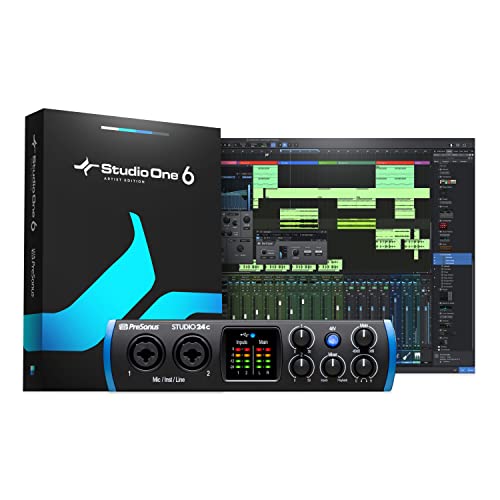
The audio interface is a mobile-ready, bus-powered device that comes in a 2-in/2-out USB-C format. With this device, users do not require a power supply as it comes with USB-C to C and USB-C to A cables for easy connection to compatible devices.
The device is equipped with two XMAX-L solid-state mic preamps that capture every detail of the sound, ensuring high-quality recordings. The studio-grade converters allow for up to 24-bit/96 kHz recording and playback, ensuring that the user has clear, crisp audio.
Users can stay on top of their recording levels with the ladder-style LED monitoring and low-latency direct monitoring. Additionally, the device comes with Studio One Artist and Ableton Live Lite DAW Recording Software, providing versatile recording options.
The device also comes with a Studio Magic Plug-In Suite that has over 1,000 USD worth of computer recording software plug-ins. This plug-in suite offers users a wide range of options to enhance their recording experience.
For guitar, bass, and other line-level devices, the audio interface is equipped with two high-headroom instrument/line inputs. The high-powered headphone output ensures that users can monitor their recordings easily.
The device also has +48V phantom power (global) for condenser microphones. Moreover, the onboard MIDI I/O provides a standard 5-pin DIN connection to keyboards and other MIDI gear.
2. Studio 1810c Audio Interface: Your Ultimate Sound Companion!
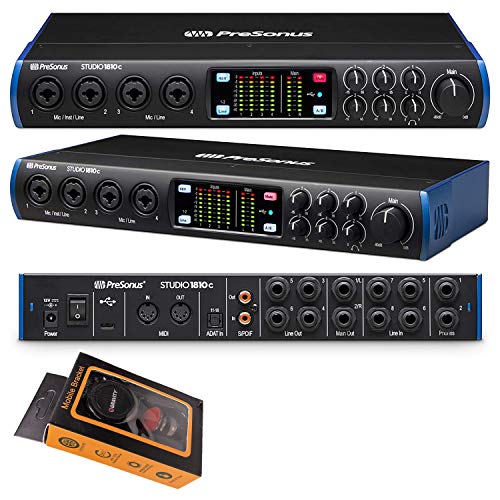
The 24-bit/192kHz USB-C 18 x 8 Audio Interface is a cutting-edge device that has been designed to cater to the needs of audio enthusiasts and professionals alike. With its impressive combination of features, it offers a high level of performance and functionality.
The device boasts an impressive 8 x 8 at 192kHz capability, which makes it an ideal choice for those who require high-quality audio recording and playback. It also comes equipped with S/PDIF I/O and MIDI I/O, which enables users to connect to a wide range of devices and peripherals.
The 2 mic/instrument/line inputs and 2 mic/line inputs are fitted with XMAX Class A mic preamps, ensuring that the audio quality is of the highest standard. Additionally, the device comes equipped with 8 channels of ADAT optical I/O (4 channels at 96kHz), providing users with a high level of flexibility and versatility.
To make things even better, the device comes with the Studio One Artist DAW software, which is a powerful tool that enables users to create, record, and produce music with ease. The LED metering on all analog inputs and main outs also ensures that users can monitor their audio levels with precision and accuracy.
The device is also equipped with 4-1/4" TRS balanced DC-coupled line outputs, which deliver a clean and clear audio signal. Additionally, it comes with 2 stereo headphone outputs with independent stream, which is perfect for collaborative recording sessions.
Finally, the package includes a USB-C to USB-C and USB-C to USB-A cable, ensuring that users have everything they need to get started right out of the box. Whether you're a beginner or an experienced professional, this audio interface is a must-have for anyone who requires high-quality audio recording and playback.
3. Onyx Producer – Versatile Audio Interface Bundle
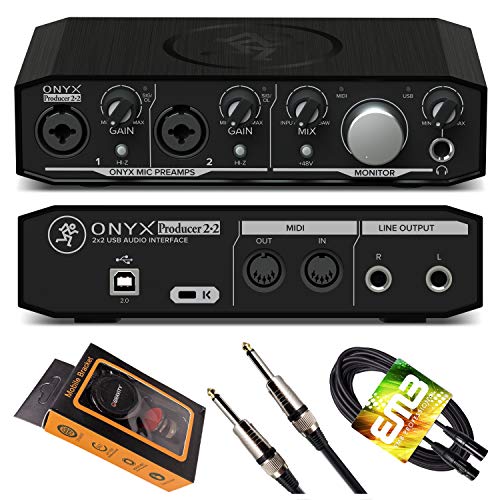
The 2-in-2-out USB 2.0 audio interface is a high-speed, low-latency device that provides exceptional sound quality. Equipped with 24-bit/192kHz converters, this premium audio interface delivers top-notch sound that is sure to impress even the most discerning audiophile.
One of the standout features of this audio interface is its two boutique-sounding Onyx mic preamps. These preamps provide excellent fidelity and dynamic range, ensuring that your recordings sound as natural and lifelike as possible. Additionally, the interface features +48v phantom power, which is ideal for studio condenser microphones.
The XLR/TRS combo inputs on this audio interface are designed to accommodate just about everything, making it a versatile and essential tool for any recording setup. Whether you're recording vocals, instruments, or anything in between, this interface is sure to deliver the high-quality sound you need.
4. Tascam 4x4hr Usb Audio Interface: Versatile Recording Hub
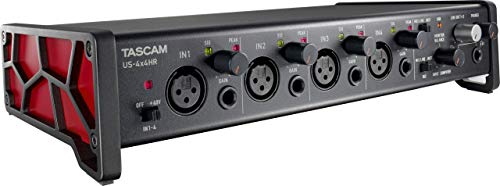
Introducing the 4-in/4-out USB audio interface, a versatile and high-performing device for recording and producing audio. With the ability to support up to 24-bit/ 192kHz audio formats, this interface delivers exceptional sound quality for professional-grade recordings.
One of the standout features of this device is the improved TASCAM driver, which now includes selectable buffer size from 4 samples, providing low-latency and stability. The TASCAM native driver for Windows ensures seamless performance, making it easy to focus on the creative process.
Equipped with 4 XLR/TRS combo inputs, this interface offers flexibility in recording different types of audio sources. The Ultra-HDDA mic preamps and +48V phantom power provide clear and crisp audio signals, making it ideal for capturing vocals, acoustic instruments and more.
Additionally, the combo TRS line inputs with guitar input support on IN1-2 allow for direct recording of guitars, making it a great choice for guitarists looking to record their performances.
5. Midas-Powered Usb Audio Interface For Audiophiles.
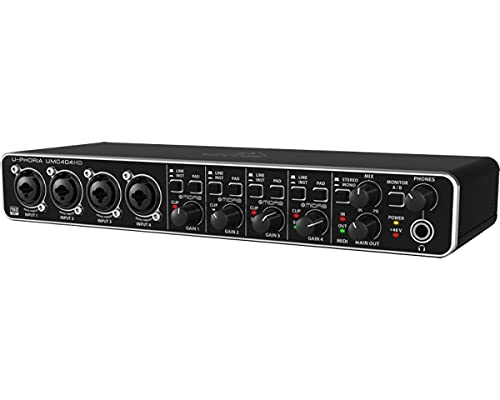
The 4×4 USB 2.0 Audio/MIDI interface is the perfect tool for recording vocals and instruments with ease. Boasting an audiophile 24-bit/192 kHz resolution, this interface ensures professional audio quality that is unmatched in the industry.
Equipped with four state-of-the-art, MIDAS designed mic preamplifiers and +48 V phantom power, this interface provides crystal clear sound and is perfect for recording anything from a soft-spoken vocalist to a thunderous drummer.
This interface is compatible with popular recording software, including Avid Pro Tools, Ableton Live, Steinberg Cubase, and many more, making the recording process a breeze.
With ultra-low latency, the 4×4 USB 2.0 Audio/MIDI interface streams four inputs and four outputs plus one MIDI I/O to your computer, supporting Mac OS XP and Windows XP or higher.
The "Built-like-a-tank" impact-resistant metal chassis is designed and engineered in Germany, providing the durability and dependability that recording professionals need.
6. Elgato Wave Xlr Mixer: Stream, Record, Podcast.
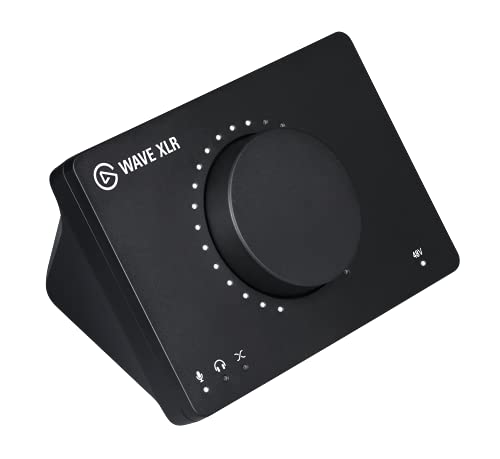
The Microphone Interface is a top-quality XLR to USB-C connection that ensures high-fidelity audio transfer from your microphone to your device. This interface is perfect for content creators, podcasters, and musicians who demand professional-grade audio quality.
With the Wave Link App, you can mix multiple audio sources and create two independent mixes. This feature allows you to easily manage and control your audio inputs, making it easy to create the perfect blend for your project. The app is intuitive and easy to use, making it a perfect tool for both beginners and professionals.
The proprietary Clipguard Technology is a unique feature that prevents microphone distortion, ensuring that your audio remains clear and crisp. This technology is especially useful for podcasters and content creators who want to ensure that their audio is of the highest quality.
The Studio Grade Preamp provides up to 75 dB of ultra-low-noise gain, which amplifies insensitive mics and ensures that your audio is crystal clear. This feature is perfect for musicians and podcasters who want to capture the nuances of their performance without any interference or noise.
Additionally, the Phantom Power feature provides 48 volts to drive condenser microphones, ensuring that you have all the power you need to capture your audio with maximum clarity. Overall, the Microphone Interface is a must-have for anyone who wants to achieve professional-grade audio quality and take their content creation to the next level.
7. Zoom U-44: Midi-Ready, Portable Audio Interface
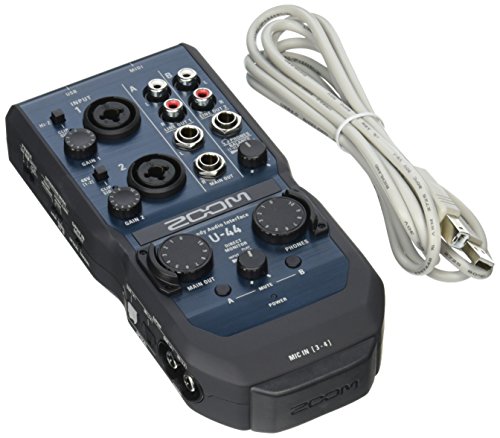
The USB audio interface for PC/Mac is a versatile and reliable device that offers multi-channel and stereo connectivity. This interface is perfect for music production, podcasting, and live recording, and it can be connected to an iPad using the Apple iPad Camera Connection Kit or Lightning-to-USB Camera Adapter (sold separately). It can also be powered by 2 AA batteries or an optional AC adapter.
The Zoom interchangeable input capsules can be connected to this interface via a 10-pin connector, making it a great choice for musicians who want to capture high-quality audio on-the-go. The standalone AD/DA conversion ensures that the audio signals are converted with accuracy and minimal noise, resulting in pristine recordings.
The USB audio interface is capable of recording and playback at resolutions up to 24-bit/96 kHz, providing high-quality sound for professional-level recording. Whether it's a solo project or a full band recording, this device offers the versatility and quality that musicians and audio engineers require.
8. Maonocaster Pro Bundle: Perfect For Podcasts & Streaming!
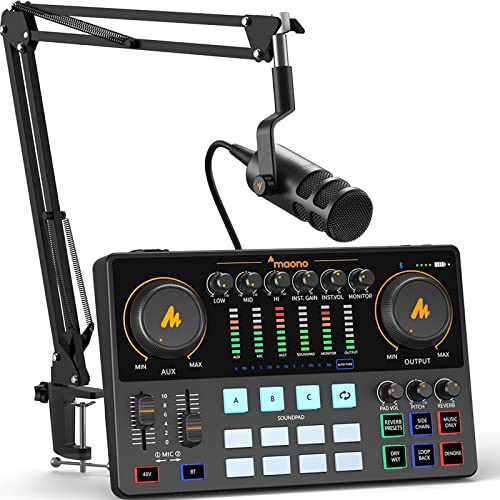
The AME2 audio interface mixer is a top-of-the-line podcast equipment bundle that comes with a premium XLR dynamic microphone, a table clip, a boom arm, a USB A-C charging cable, two 3.5mm TRRS audio cables, and a user manual. The package list also includes one XLR microphone cable for connecting your microphone to the audio interface.
The AME2 audio interface mixer features built-in quality preamps that support phantom power for optimal performance of XLR microphones. The preamps allow for 3-level mic gain adjustment, supporting ultra-low noise gain up to 60dB, and high-end dynamic microphones such as SM7B/SM58 and SM58. The 48V phantom power brings the condenser microphone to life, while the 32-bit high-performance chipset and DENOISE function provide clearer sound.
The AME2 10-channel podcast mixer allows for 11 customizable sound pads. You can adjust the volume of each sound pad as well. Our digital audio workstation controllers allow you to upload your favorite audio for podcast recording via smartphone, PC, microphone, or Bluetooth device. 3 sound pads support recording of up to 60s of audio each and feature one-key looping, while the remaining 8 support 20s of audio.
The AME2 audio interface mixer is perfect for guitar, bass, and other musical instruments with a 6.35mm jack. With the high headroom instrument input, you don't have to sacrifice the tone, and you can get a perfect recording.
The XLR dynamic microphone included in the package has a built-in dynamic core and inner double-layer pop filter. The noise isolation technology provides better attenuation of plosives, resulting in well-balanced reproduction across a wide frequency response range of 60-14kHz, delivering clean and mellow audio.
The AME2 audio interface mixer is designed for live-streaming and podcast recording. You can use USB-C to connect your computer or tablet, LIVE-OUTPUT1/2 to connect your smartphone for podcast recording and streaming, and MONITOR SPK to connect a studio monitor for sound output. Use the AUX-IN jack to connect your input accompaniment from a smartphone or other devices, MIC1/2 to connect your favorite XLR condenser/dynamic microphone, and INST to connect your guitar/bass or other instruments.
The audio interface mixer has six reverb modes that you can adjust freely, 12-step auto-tune, 3 modifiable tones (Treble, mid-range, bass), and pitch changer knobs. Each microphone input is independently controlled, and pro features like sidechain, music-only, and loopback switches are included.
The AME2 audio interface mixer is plug-and-play ready, offers crystal-clear audio recording, and has a sleek design that gives your home studio a professional touch. It is perfect for podcast recording, streaming, voice-overs, and content creation. The equipment is compatible with PC, smartphones, tablets, cameras, Windows, Mac OS, and more.
9. Fireface Ufx Ii: Ultimate Audio Solution

The audio experience is taken to a whole new level with the top-of-the-line AD/DA converters, optimized analog circuits, and impressive SNR of this product. The result is crystal clear and transparent audio that is sure to impress even the most discerning audiophile.
The product boasts a wide range of connectivity options, including Analog, ADAT, AES, S/PDIF, and USB 2, making it easy to integrate into any production environment. This versatility also ensures that the product is compatible with a wide range of devices, providing maximum flexibility.
The 4 pad-free mic circuits are designed to deliver an impressive +18dBu of maximum input level and 75dB of gain. This means that users can enjoy optimal performance, even when working with lower-level inputs.
The low impedance, high power headphone outputs provide superior monitoring, allowing users to hear every detail of their audio clearly. This feature is especially useful during production, where it is essential to ensure that every sound is captured accurately.
The product can also be integrated with RME’s optional ARC USB remote controller, making it even easier to control and customize the audio experience.
10. Antelope Audio Discrete 4 Synergy Core Thunderbolt And Usb Audio Interface With 37 Fx Included

The Desktop 4×10 Thunderbolt 2 & USB 2.0 audio interface is a high-quality device designed for Mac and Windows users who demand exceptional sound quality. This mobile package boasts 4 discrete 6-transistor preamps that offer ultra-low noise and vanishingly low distortion, ensuring that recordings of your instruments and vocals are lush, bold, and expansive. The AD/DA converters provide articulate audio reproduction, while a monitor converter with pristine conversion ensures that the sound quality is exceptional.
One of the standout features of this audio interface is the 37 real-time analog-modeled plugins that are included. This plugin library consists of emulations of the most coveted and hard-to-find studio analog gear from around the world, ranging from a rare Austrian-born EQ to legendary British solid-state processing. The collection is constantly growing, with a library of expansions available in the Antelope software store.
The onboard processing capability is another impressive feature of this audio interface. With near-zero latency, users can apply the plugins while mixing or tracking live. They can work on a session with up to 32 plugins loaded simultaneously without CPU load, thanks to the Synergy Core onboard platform for real-time plugin processing. This feature provides users with a flexible and efficient workflow, allowing for a seamless recording experience.
In addition to its exceptional sound quality and plugin capabilities, this audio interface also offers other connections. It has four DC-coupled line outputs on TRS 1/4 jack, S/PDIF & ADAT, two word clock outs, four stereo headphone outs, and a stereo monitor out. Users can route all their audio through a flexible software matrix, resulting in a highly versatile device that can handle a wide range of recording setups.
Best 4 Preamp Audio Interface FAQs
Can preamp audio interfaces be used for live performances?
Yes, preamp audio interfaces can be used for live performances. In fact, many musicians and live sound engineers use them for this purpose. A preamp audio interface is a device that amplifies the audio signal coming from an instrument or microphone before it is sent to a computer or recording device. This amplified signal can then be used for live performances as well.
Using a preamp audio interface for live performances can provide several benefits. Firstly, it can improve the sound quality of the audio signal, resulting in a clearer and more defined sound. Secondly, it can provide greater control over the audio signal, allowing for adjustments to be made in real time. Lastly, it can help eliminate noise and interference that may be present in the audio signal.
When using a preamp audio interface for live performances, it is important to ensure that it is compatible with the audio equipment being used. Additionally, it is important to properly set the gain levels to avoid distortion or clipping of the audio signal.
How do I properly set up and use a preamp audio interface for optimal performance?
Setting up and using a preamp audio interface can be a bit tricky, but following these steps can help you achieve optimal performance:
1. Connect the preamp audio interface to your computer via USB or Firewire. Make sure you have installed the necessary drivers and software.
2. Connect your microphone or instrument to the preamp using XLR or TRS cables. Make sure your cables are of good quality to avoid any interference.
3. Turn on your preamp and adjust the gain level to avoid any clipping or distortion. You can do this by starting with a low gain level and gradually increasing it until you get a good signal level without any clipping.
4. Set your input level on your computer's audio software. This is usually located in the preferences or settings section of your software.
5. Test your setup by recording some audio and listening back to it. If you hear any noise or interference, try adjusting your gain level or moving your cables away from any other electrical devices.
Remember to always read the manual of your preamp audio interface to get the best performance out of it.
How important are preamps in the recording process?
Preamps are an essential component in the recording process as they play a crucial role in capturing the sound of any instrument or voice. The preamp's primary function is to amplify the weak signal that comes from the instrument or microphone and increase its level to a line-level signal that can be recorded by the recording device.
A high-quality preamp can make a significant difference in the sound quality of the recorded audio. It can add warmth, depth, and clarity to the sound, which can make the recording more engaging and professional-sounding. A good preamp can also help to reduce noise and distortion in the recording, which is especially important when recording with dynamic microphones.
However, it's worth noting that not all preamps are created equal, and the quality of the preamp can vary depending on the manufacturer and the price point. Therefore, it's crucial to choose a preamp that suits your recording needs and budget.
In summary, preamps are an essential component in the recording process, and a high-quality preamp can make a significant difference in the sound quality of the recorded audio.
What are some common issues that can arise when using preamp audio interfaces?
Preamp audio interfaces are essential tools for recording audio, but they can also come with some common issues that can affect the quality of the recordings. One of the most common problems is noise, which can be caused by interference from other electrical devices or poor grounding. This noise can manifest as hissing or buzzing sounds in the recording. Another issue is distortion, which occurs when the preamp is pushed too hard and can result in a harsh, unpleasant sound.
Additionally, preamp audio interfaces can also suffer from issues related to gain staging. If the gain is set too high, it can lead to clipping, which is when the signal exceeds the maximum level that the interface can handle. On the other hand, if the gain is set too low, it can result in a weak and quiet recording that requires more processing in post-production.
To avoid these issues, it's important to choose a high-quality preamp audio interface that has good shielding and grounding. Additionally, it's crucial to properly set the gain levels to avoid clipping or weak recordings. Finally, it's recommended to use high-quality cables and to keep the interface away from other electrical devices that may cause interference.
What are the key features to look for when selecting the best 4 preamp audio interfaces?
When selecting the best 4 preamp audio interfaces, there are several key features that you should consider to ensure that you get the best device for your needs.
Firstly, you should consider the number of preamps that the audio interface provides. As you are looking for a 4 preamp audio interface, you should ensure that the device indeed has four preamps.
Secondly, you should consider the quality of the preamps. Good preamps provide clean and transparent sound with low noise, and they should also have enough gain to amplify low-level signals without introducing distortion.
Thirdly, you should consider the connectivity options available on the audio interface. A good 4 preamp audio interface should have a range of input and output options, including line-level, instrument-level, and digital inputs and outputs.
Fourthly, you should consider the compatibility of the audio interface with your computer and recording software. Make sure that the device is compatible with your computer's operating system and recording software.
Finally, you should consider the build quality and durability of the audio interface. Look for a device that is well-built and can withstand the rigors of regular use in a recording studio or on the road.
Overall, by considering these key features, you can select the best 4 preamp audio interface for your needs and ensure that you get the best sound quality for your recordings.
What are the top 4 preamp audio interfaces currently available on the market?
There are many preamp audio interfaces available on the market, but some stand out from the rest. Here are the top 4 preamp audio interfaces currently available:
1. Universal Audio Apollo Twin MkII: This interface is known for its high-quality preamps, excellent conversion, and real-time UAD processing capabilities. It's a popular choice among professional musicians and producers.
2. Focusrite Scarlett 2i2: This interface is a favorite among beginners and home studio enthusiasts. It's affordable, easy to use, and has great sounding preamps.
3. Audient iD4: The Audient iD4 is a compact and portable interface that packs a punch. It has excellent preamps and conversion, and features a simple and intuitive design.
4. PreSonus Studio 192: The PreSonus Studio 192 is a versatile interface that offers 8 high-quality preamps, extensive connectivity options, and advanced monitoring features. It's a great choice for professional studios or those who require a lot of inputs.
What is the difference between a preamp audio interface and a regular audio interface?
A preamp audio interface and a regular audio interface differ in their audio signal chain and functionality. A preamp audio interface includes a built-in preamplifier, which is responsible for boosting the microphone or instrument level audio signal to line level. This allows for a stronger and clearer signal to be sent to the computer or recording device.
On the other hand, a regular audio interface does not include a preamplifier and relies on an external preamp or mixer to boost the signal level. This makes it more suitable for those who have already invested in high-quality standalone preamps or mixers.
Another difference between the two is the number of inputs and outputs available. Preamp audio interfaces usually have fewer inputs and outputs than regular audio interfaces, as they are designed for recording one or two tracks at a time. Regular audio interfaces, on the other hand, have more inputs and outputs to accommodate recording multiple instruments or microphones simultaneously.
In summary, the main difference between a preamp audio interface and a regular audio interface is the inclusion of a preamplifier, which provides a stronger and clearer audio signal, and the number of inputs and outputs available.
What is the price range for the best 4 preamp audio interfaces?
The price range for the best 4 preamp audio interfaces can vary depending on the brand, features and quality. However, generally speaking, you can expect to pay anywhere between $500 to $1500 for a high-quality 4 preamp audio interface. Some of the most popular options in this price range include the Universal Audio Apollo x4, Focusrite Clarett 8PreX, Audient iD44 and the PreSonus Studio 1824c. These interfaces offer a range of features such as low latency, high resolution, multiple inputs and outputs, and compatibility with various DAW software. It is important to carefully consider your specific needs and budget before making a purchase, and to read reviews and compare different models to find the best option for you.
What types of microphones work best with preamp audio interfaces?
When it comes to choosing a microphone for your preamp audio interface, there are a few factors to consider. The type of microphone you select will depend on the type of audio you are recording, your budget, and the type of preamp you have.
There are three main types of microphones: dynamic, condenser, and ribbon. Dynamic microphones are rugged and durable, making them ideal for recording live music performances. Condenser microphones are more sensitive and responsive, making them ideal for recording vocals and acoustic instruments. Ribbon microphones are known for their warm, natural sound and are often used for recording brass and string instruments.
When it comes to selecting a microphone for your preamp audio interface, it's important to consider the impedance matching between the microphone and the preamp. A preamp with a high impedance will work best with a condenser microphone, while a preamp with a low impedance will work best with a dynamic microphone.
Ultimately, the best microphone for your preamp audio interface will depend on your specific needs and preferences. It's always a good idea to do your research and test out different microphones before making a purchase.
Which brands are known for producing high-quality preamp audio interfaces?
There are several brands that are known for producing high-quality preamp audio interfaces. One of the most popular brands is Universal Audio, which is known for their Apollo series of audio interfaces. These interfaces are known for their high-quality preamps and their ability to emulate classic analog gear. Another popular brand is Focusrite, which produces the Scarlett series of audio interfaces. These interfaces are known for their low latency and high-quality preamps. Apogee is another brand that is known for producing high-quality preamp audio interfaces. Their Ensemble and Duet series of audio interfaces are popular among professional musicians and producers. Other brands that are known for producing high-quality preamp audio interfaces include PreSonus, MOTU, and RME. Ultimately, the best preamp audio interface for you will depend on your specific needs and budget. It's important to do your research and read reviews before making a purchase.
